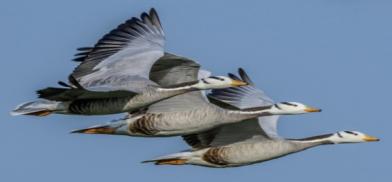Bar-headed geese worst hit by bird flu in Pong wintering ground
Nestled in the sylvan surroundings of the Kangra valley in Himachal Pradesh, the Pong Dam wetlands in the foothills of the Himalayas are normally agog with flapping of feathered guests each winter

Nestled in the sylvan surroundings of the Kangra valley in Himachal Pradesh, the Pong Dam wetlands in the foothills of the Himalayas are normally agog with flapping of feathered guests each winter. Its silvery-green waters, verdant forests, shrubbery islands, grassy swamps and aquatic life make the reservoir a paradise for migratory birds.
But this winter, for the first time in recent decades, birds in the 307-square km Pong wetlands are hit by avian influenza H5N1. And the worst affected species is one of world's highest-altitude fliers, the bar-headed goose, an endangered species that regularly descend in India.
The Pong wetlands, one of the largest man-made wetlands in northern India, have emerged as the preferred wintering ground of the bar-headed goose.
At the annual waterfowl estimation coordinated by the state wildlife wing in 2015, a staggering 71,800 bar-headed geese, probably half their numbers globally, were recorded in the Pong wetlands, an all-time high till date. A total of 49,496 bar-headed geese were recorded in January 2020. Around 23,000 and 28,160 geese were recorded in 2009 and 2008, respectively.
The gregarious goose feeds at night in the grasslands on riverbanks and breeds in high-altitude lakes in Central Asia, including Tibet and Ladakh.
With the death toll of migratory waterbirds in the Pong wetlands rising to 4,020, and almost 90 per cent of them being notable visitors, the bar-headed goose, the state wildlife authorities blamed the avian influenza (H5N1) for the disaster.
Principal Chief Conservator Forest, Wildlife, Archana Sharma, told IANS that 318 dead birds were found in the Pong catchment on Saturday and with them the total number of mortality of birds rose to 4,020.
She said the ICAR-National Institute of High Security Animal Diseases (NIHSAD) based in Bhopal has confirmed that avian influenza virus (H5N1) was responsible for their mortality.
The Pong wetlands are also home to many native birds like the red jungle fowl, large Indian parakeet, Indian cuckoo, bank mynah, wood shrike, yellow-eyed babbler, black ibis, paradise flycatcher, crested lark and the crested bunting.
A total of 425 species of birds, both migratory and local, 18 of snake, 90 of butterfly, 24 of mammals and 27 of fish have been recorded so far in Pong.
(IANS)









Post a Comment